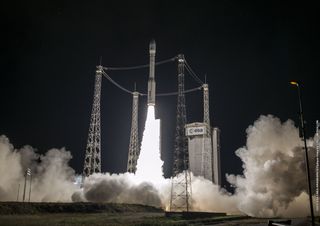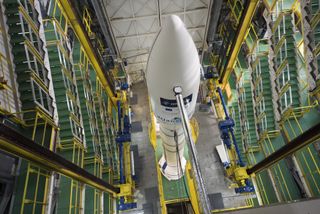Vega: Europe's Light Launcher

Vega is a rocket operated by Arianespace to send small spacecraft or payloads to polar and low Earth orbits. It was developed jointly by the European Space Agency and the Italian Space Agency, with assistance from other entities and has been launching since 2012. Vega is named after the brightest star in the constellation Lyra.
As of May 2018, Vega has had 11 launches — all of them successful. Its notable launches include the IXV European spaceplane, and the LISA Pathfinder mission that tested out technology to seek gravitational waves in space.
The European Space Agency plans a successor to Vega called Vega C (Consolidation), which will send up to 2,300 kilograms (5,070 lbs.) to low-Earth orbit (LEO) — 60 percent more than Vega. Its first flight is expected in 2019. Further in the future, the Vega Evolution (Vega E) is planned, which would include a more powerful liquid oxygen/liquid methane upper stage. Its first launch is scheduled for 2024.
Physical characteristics
Height: 98 feet (29.9 meters)
Number of stages: 4 — 3 with solid propellants; 4th stage is the AVUM (Attitude & Vernier Upper Module) with liquid-propellant
Payload capacity to 125 miles (200 km): 5,500 lbs. (2,500 kg)
Capacity to International Space Station: 4,409 lbs. (2,000 kg). The ISS has an average orbit of 250 miles (400 km).
Capacity to 500 miles (800 km): 2,900 lbs. (1,300 kg)

History
Vega's first launch was on Feb. 13, 2012, after nine years of development. The rocket successfully launched nine satellites into orbit, including the LARES laser relativity satellite, ALMASat-1, and seven CubeSats.
The first commercial launch took place on May 7, 2013, marking Vega's second launch altogether. The rocket hefted three satellites into space: the European Space Agency's Proba-V, the Vietnamese VNREDSat-1 and the Estonian ESTCube-1 satellite. [Photos: Meet Vega, Europe's New Rocket]
On Feb. 11, 2015, Vega launched a European spaceplane, called IXV, to suborbital space. The plane passed all of its major milestones without issue, and another test flight was planned for 2019. IXV landed safely in the ocean after 100 minutes; the next mission may have a touchdown on land, using either a landing gear or a parachute-like parafoil.
Later in 2015, a Vega rocket successfully launched the LISA Pathfinder mission that December. The test spacecraft was supposed to try out technologies to observe gravitational waves from space. The mission successfully operated until July 2017, when it was shut down as planned. A successor mission called LISA will have three satellites positioned in a triangle, roughly 1.55 million miles (2.5 million kilometers) from each other, to hunt gravitational waves. It will launch in 2034.
[In Photos: Earth 'Sentinel' Satellite Blasts off on Vega Rocket]
By August 2017, Vega's track record was catching attention among space observers. "Vega now has 10 missions completed since debuting in 2012, launching successfully each time — a feat for the harrowing early days of any launch system where failures are all but expected," wrote SpaceNews.com.
Additional resource
Join our Space Forums to keep talking space on the latest missions, night sky and more! And if you have a news tip, correction or comment, let us know at: community@space.com.
Get the Space.com Newsletter
Breaking space news, the latest updates on rocket launches, skywatching events and more!

Elizabeth Howell (she/her), Ph.D., is a staff writer in the spaceflight channel since 2022 covering diversity, education and gaming as well. She was contributing writer for Space.com for 10 years before joining full-time. Elizabeth's reporting includes multiple exclusives with the White House and Office of the Vice-President of the United States, an exclusive conversation with aspiring space tourist (and NSYNC bassist) Lance Bass, speaking several times with the International Space Station, witnessing five human spaceflight launches on two continents, flying parabolic, working inside a spacesuit, and participating in a simulated Mars mission. Her latest book, "Why Am I Taller?", is co-written with astronaut Dave Williams. Elizabeth holds a Ph.D. and M.Sc. in Space Studies from the University of North Dakota, a Bachelor of Journalism from Canada's Carleton University and a Bachelor of History from Canada's Athabasca University. Elizabeth is also a post-secondary instructor in communications and science at several institutions since 2015; her experience includes developing and teaching an astronomy course at Canada's Algonquin College (with Indigenous content as well) to more than 1,000 students since 2020. Elizabeth first got interested in space after watching the movie Apollo 13 in 1996, and still wants to be an astronaut someday. Mastodon: https://qoto.org/@howellspace
